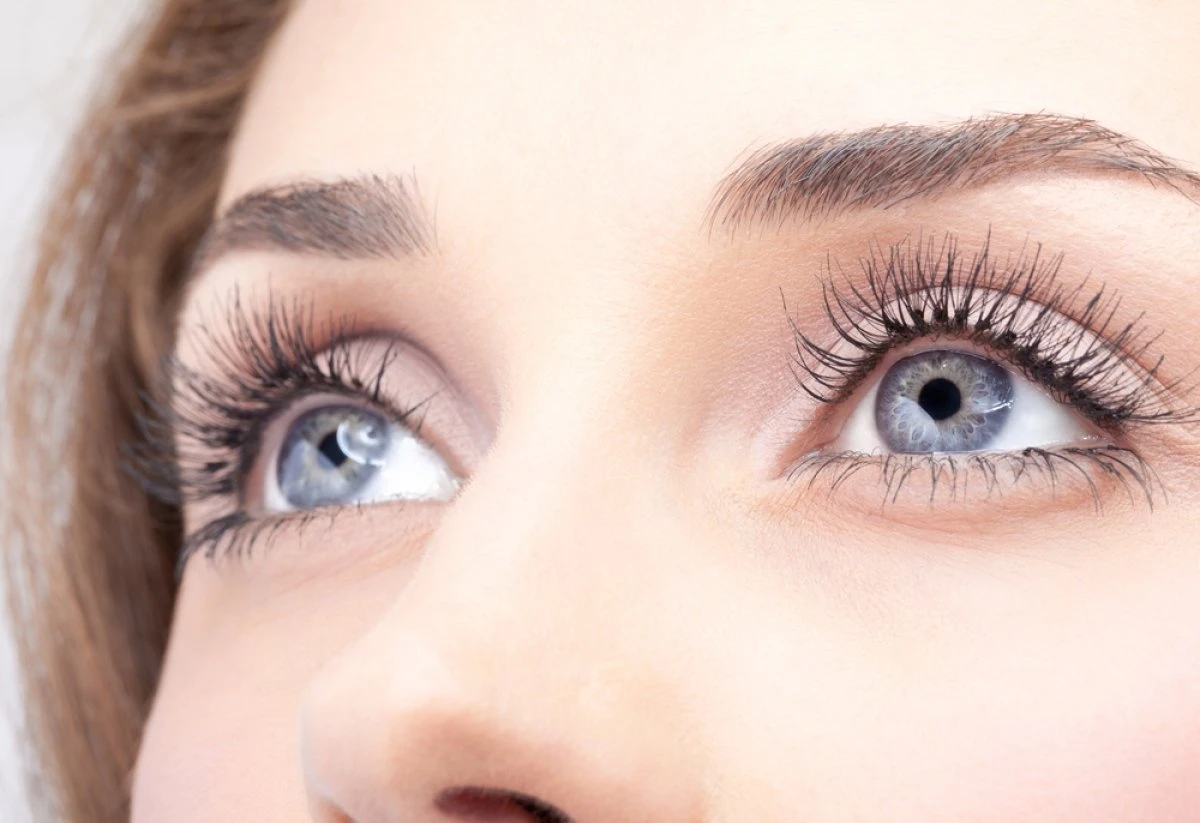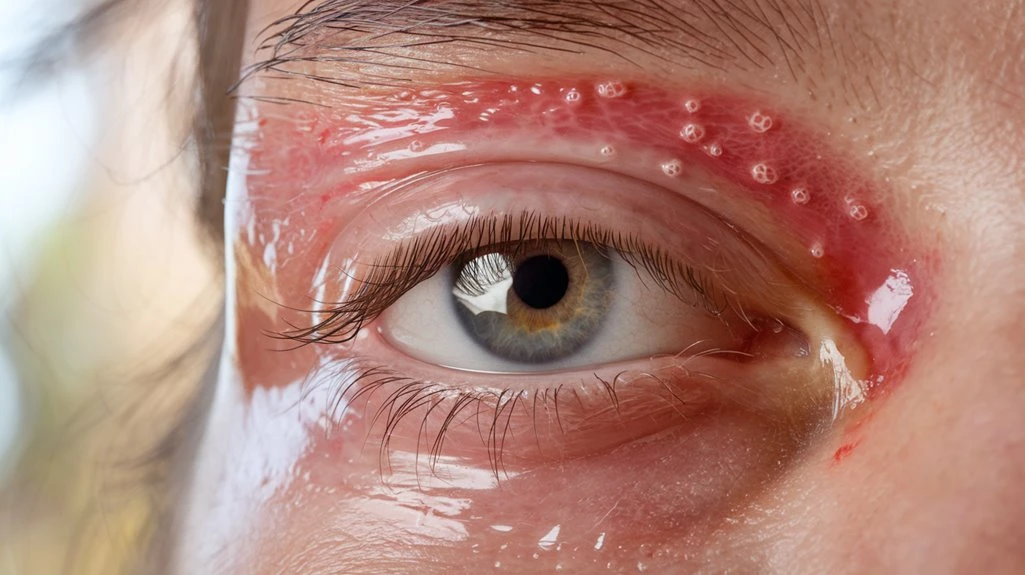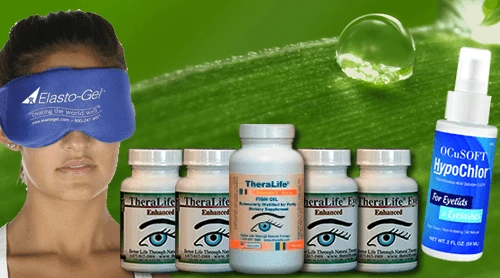TheraLife’s products provide significant benefits to customers experiencing eyelid inflammation due to bacterial infection. The products are designed to reduce redness and swelling along the lid margin, manage purulent discharge, and alleviate crusting of the eyelashes after sleep. TheraLife’s formulations help relieve persistent itching, burning, and localized tenderness, also preventing eyelids from sticking upon waking. Additionally, they address symptoms like excessive tearing, eyelash misdirection, and recurrent styes and chalazia. While vision typically remains clear during these infections, any blurring should be promptly addressed. TheraLife offers a comprehensive solution for those seeking effective relief and prevention of eyelid inflammation symptoms.
Best Eyelid Inflammation Treatment From TheraLife- When Drops Don’t Work.
Key Takeaways
- Redness, swelling, and tenderness along the eyelid margin are common early signs of bacterial eyelid infection.
- Yellow or greenish, thick purulent discharge and eyelash crusting after sleep suggest bacterial involvement.
- Persistent localized pain, especially with eyelid movement or palpation, often indicates a bacterial cause.
- Recurrent styes or chalazia with ongoing eyelid inflammation point to chronic bacterial colonization.
- Bacterial eyelid infections rarely cause vision loss, but excessive tearing and mild transient visual disturbance may occur.
Redness and Swelling Along the Eyelid Margin
Importantly, redness and swelling along the eyelid margin aren’t exclusive indicators of bacterial infection.
When you assess eyelid inflammation, consider that these signs might result from non-bacterial etiologies such as allergic reactions, irritant exposure, or underlying dermatological conditions. Clinical presentation often includes erythema and localized edema, possibly accompanied by tenderness.
If you neglect eyelid hygiene, you may exacerbate symptoms or predispose the area to secondary infection. However, these findings alone don’t confirm bacterial involvement. It’s critical to evaluate patient history, risk factors, and associated systemic symptoms.
Given the global concerns regarding bacterial resistance, judicious use of antibiotics is essential. Relying strictly on redness and swelling without further diagnostic evidence could contribute to unnecessary antimicrobial exposure and complicate future treatment options. Meibomian gland dysfunction is another potential cause of eyelid inflammation, often seen in conjunction with posterior blepharitis which can lead to blocked oil glands and dry eyes.
Presence of Yellow or Greenish Discharge
The presence of yellow or greenish discharge from the eyelid margin frequently raises suspicion for bacterial infection, yet this sign alone lacks sufficient specificity. When you assess discharge color, note that yellow or greenish hues commonly indicate purulent material, reflecting neutrophilic infiltration often associated with bacterial pathogens such as Staphylococcus aureus or Streptococcus species. However, you shouldn’t depend solely on color, as viral or non-infectious etiologies might occasionally present similarly. Evaluate discharge texture in detail—bacterial infections typically produce a thick, mucopurulent exudate, while other causes may yield a more watery or serous secretion. Additionally, noting the frequency and persistence of the discharge can help differentiate bacterial from non-bacterial disorders. Styes, for example, are a common bacterial infection affecting glands near eyelashes, presenting as red, swollen bumps resembling boils or pimples. Always integrate findings with additional clinical signs to guarantee an accurate diagnosis.
Crusting on the Eyelashes After Sleep
Crusting on the eyelashes after sleep, often referred to as “morning crust,” commonly arises when dried secretions accumulate along the lid margin overnight.
You may notice crusty eyelashes upon awakening, with debris consisting of dried mucous, bacterial exudate, and epithelial cells. This adherent crust can cause eyelash matting, making it difficult to open your eyes in the morning.
Clinically, such findings are frequently associated with anterior blepharitis due to bacterial overgrowth, typically Staphylococcus species.
Poor sleep hygiene and inadequate eyelid cleansing can exacerbate crust formation by allowing microbial proliferation and uninterrupted accumulation of secretions.
Persistent or worsening morning crust may indicate an ongoing bacterial infection rather than a transient physiological event.
Proper assessment involves evaluating the color, consistency, and frequency of crusting to guide targeted management strategies.
Inflammatory mechanisms play a crucial role in the development of blepharitis and can exacerbate symptoms if left untreated.
Persistent Itching or Burning Sensation
A persistent itching or burning sensation along your eyelid margin frequently signals an underlying inflammatory response, which may be driven by bacterial colonization.
When you notice such discomfort, it’s essential to differentiate between bacterial involvement and other contributing factors, such as allergy triggers or chronic skin conditions like seborrheic dermatitis and atopic dermatitis.
Bacteria such as Staphylococcus aureus often exacerbate inflammatory changes at the eyelid margin, causing direct irritation to the skin and follicular structures, perpetuating the urge to scratch or rub your eyes.
This mechanical trauma can break down the protective barrier, providing further access for pathogens.
While allergy triggers commonly present with pruritus, bacterial infections characteristically introduce a burning component, highlighting the importance of evaluating both symptom quality and your clinical history for accurate diagnosis.
Consistent application of warm compresses has been shown to effectively manage symptoms associated with eyelid inflammation by improving circulation and facilitating natural drainage of blocked glands.
Eyelid Tenderness and Pain
You may experience localized tenderness and pain along the eyelid margin, often indicating bacterial involvement of the soft tissue.
This discomfort can intensify with palpation or during eye movements, reflecting inflammation of the underlying structures.
Sensitivity in these areas serves as a key clinical marker when differentiating bacterial from non-infectious etiologies of eyelid inflammation.
In addition, Staphylococcal blepharitis is a common cause of bacterial eyelid inflammation, particularly in children, and often requires appropriate antibiotic treatment to manage symptoms effectively.
Best Eyelid Inflammation Treatment From TheraLife- When Drops Don’t Work.
Identifying Localized Discomfort
How do clinicians recognize the early signs of bacterial eyelid inflammation? You should focus on identifying localized discomfort, as this can be a primary marker of infection. Typically, patients report localized irritation on the eyelid, manifesting as increased eyelid sensitivity to palpation. Precise assessment involves questioning the patient about focal pain and visually inspecting the area for erythema or swelling. Direct examination will often reveal tenderness when you gently apply pressure to the affected eyelid segment. In cases of blepharitis, maintaining eyelid hygiene is crucial to prevent bacterial growth and manage symptoms effectively.
Below is a summary table guiding clinical assessment:
| Symptom | Clinical Finding | Diagnostic Value |
|---|---|---|
| Localized irritation | Redness/swelling | High for infection |
| Eyelid sensitivity | Pain on palpation | Suggestive |
| Focal erythema | Defined inflamed area | Moderate |
| Absence of discharge | Non-purulent infection | May occur |
| Mild warmth | Increased temperature | Supportive |
Sensitivity During Eye Movements
Once localized discomfort is identified, evaluating sensitivity during eye movements offers further diagnostic clarity.
You may notice heightened eyelid tenderness or pain, particularly when you direct your gaze across different planes—upward, downward, or side to side. This sensation frequently accompanies bacterial eyelid inflammation, as movement increases pressure on inflamed structures.
You could also experience eye fatigue and vision strain, especially following sustained ocular activity. Clinically, pain exacerbated by movement indicates potential involvement of periocular soft tissues, like the lid margin or adjacent glands.
Document whether discomfort intensifies with blinking, saccadic motion, or during convergence tasks. Such detailed observation helps distinguish infectious causes from other etiologies, such as allergic or mechanical irritation.
Promptly note any associated swelling, redness, or functional vision changes to inform targeted treatment approaches.
Many styes are caused by Staphylococcus aureus bacteria, which is commonly found on the skin and can lead to infections when hygiene is poor.
Formation of Small Bumps or Ulcers
Distinct elevations or ulcerations on the eyelid, often presumed to indicate bacterial infection, don’t reliably serve as diagnostic markers.
When you encounter a small bump along the eyelid margin, assess its characteristics: a painless, firm nodule may suggest a chalazion, whereas a tender, erythematous papule could indicate a stye.
However, these bump characteristics aren’t exclusive to bacterial etiologies; noninfectious causes frequently present similarly.
Regarding ulcer types, you might notice superficial erosions or deeper necrotic lesions. Superficial ulcers within the tarsal conjunctiva or eyelid margin can stem from mechanical irritation or autoimmune conditions, not only infection.
Styes, or hordeolums, are painful bumps on the eyelids caused by bacterial infections, typically Staphylococcus, and they usually heal within 2 to 3 weeks.
Consequently, while the presence of bumps or ulcers can raise suspicion, you shouldn’t use these morphologic changes alone to identify bacterial involvement in eyelid inflammation.
Excessive Tearing or Watery Eyes
You may experience excessive tearing, known as epiphora, when bacterial eyelid inflammation disrupts normal tear duct function. This abnormal tear production or drainage often causes blurred vision and persistent ocular discomfort. Recognizing this symptom helps differentiate bacterial causes from other etiologies of eyelid inflammation. Incorporating hyaluronic acid into your eye care routine can improve tear film stability and provide relief from dry eye symptoms.
Connection to Tear Ducts
Although eyelid inflammation and bacterial infection may cause a range of ocular symptoms, clinical evidence does not support a direct association with excessive tearing or watery eyes caused by tear duct involvement. When you examine tear duct anatomy, you’ll find that the lacrimal drainage system is distinct from the structures primarily affected by eyelid infections. Most cases of eyelid inflammation—such as bacterial blepharitis or hordeolum—rarely compromise tear drainage pathways. Instead, symptoms like excessive tearing typically originate from other etiologies, such as nasolacrimal duct obstruction or conjunctival irritation. Chronic dry eyes can result from autoimmune diseases, menopause, and certain medications.
Impact on Vision Clarity
While eyelid infections often present with redness, swelling, and purulent discharge, these conditions seldom result in significant changes to vision clarity caused by excessive tearing.
If you experience excessive tearing during an eyelid infection, it typically stems from irritation and increased lacrimal gland activity rather than a direct pathological effect on the eye’s refractive structures.
Clinical evidence indicates that vision impairment or persistent blurred vision is uncommon in bacterial eyelid inflammation unless the infection spreads to the cornea or intraocular structures.
Any transient visual disturbance you notice is usually due to tear film irregularities or discharge temporarily clouding the ocular surface.
If you develop sustained blurred vision or notable vision impairment, prompt ophthalmologic assessment is warranted to exclude keratitis, endophthalmitis, or more severe ocular involvement.
Loss or Misdirection of Eyelashes
Loss or misdirection of eyelashes, known clinically as madarosis and trichiasis respectively, rarely serve as primary indicators of bacterial infection in eyelid inflammation.
You’ll usually notice these findings as secondary consequences of chronic or severe eyelid disease rather than acute infection. Madarosis manifests as partial or complete eyelash loss, while trichiasis refers to the abnormal inward growth of lashes, irritating the ocular surface.
Proper eyelash care and monitoring normal eyelash growth patterns are essential in differentiating infectious from non-infectious etiologies. While chronic bacterial blepharitis can eventually disrupt follicular architecture, causing misdirection or shedding, isolated bacterial infections seldom present initially this way.
If you observe lash abnormalities, consider alternative or mixed diagnoses, such as demodex infestation, autoimmune disorders, or localized trauma, rather than attributing these changes solely to bacterial infection.
Sticking of Eyelids Upon Waking
Ever wonder why your eyelids sometimes stick together upon waking? This phenomenon often results from overnight accumulation of mucopurulent discharge. When bacterial infection drives eyelid inflammation, the dense exudate dries between your lids, effectively sealing them. Impaired eyelid hygiene exacerbates this process, allowing microorganisms and debris to proliferate. As part of your morning routines, gently cleansing the lid margins can greatly reduce residue, fostering ocular surface health and comfort. Sticking of the eyelids strongly suggests underlying microbial involvement and indicates a potential need for therapeutic intervention.
Here’s a comparison of common findings in eyelid inflammation:
| Clinical Feature | Bacterial Eyelid Inflammation |
|---|---|
| Discharge Consistency | Mucopurulent |
| Color of Discharge | Yellow or Green |
| Sensation | Grittiness, Irritation |
| Eyelid Edema | Present |
| Morning Lid Sticking | Frequently Observed |
Recurrent Stye or Chalazion Development
Even in the absence of obvious triggers, repeated formation of styes (hordeolum) or chalazia often signals chronic bacterial colonization along the eyelid margin.
When you notice recurrent inflammation or persistent nodules, it’s essential to recognize that chronic irritation can perpetuate the cycle of infection. Bacterial biofilms on the eyelash follicles or meibomian glands commonly drive these recurring episodes.
Clinically, you may observe localized erythema, tenderness, and swelling persisting or recurring despite standard therapies.
Consider these key points:
- Recurrent cases often indicate underlying bacterial overgrowth or resistant organisms.
- Inadequate eyelid hygiene exacerbates chronic irritation and increases recurrence risk.
- Early intervention with targeted antimicrobial therapy can reduce the frequency and severity of these lesions.
Prompt identification and management optimize eyelid health and symptom control.
Best Eyelid Inflammation Treatment From TheraLife- When Drops Don’t Work.
Frequently Asked Questions
Can Bacterial Eyelid Infections Spread to Others?
Yes, you can transmit bacterial eyelid infections to others through direct or indirect contact.
Bacterial transmission often occurs when you touch your infected eye and then touch shared surfaces, towels, or personal items.
To reduce the risk, practice strict infection prevention, including frequent hand hygiene, avoiding sharing personal items, and properly disposing of contaminated materials.
Evidence shows that proactive hygiene measures greatly decrease the likelihood of spreading bacterial infections to others.
Are Bacterial Eyelid Infections Contagious to Pets?
You might wonder if bacterial eyelid infections are contagious to pets. Evidence suggests most human eyelid pathogens, like Staphylococcus aureus, rarely transmit to animals.
However, immunocompromised pets could be vulnerable. To guarantee infection prevention, practice pet precautions—avoid direct facial contact and wash your hands before handling pets.
In rare cases, zoonotic transfer can occur, so staying vigilant with hygiene is key for protecting your household companions from potential bacterial exposure.
What Are Common Risk Factors for Bacterial Eyelid Infections?
Think of risk factors for bacterial eyelid infections as cracks in a fortress wall—poor hygiene practices, such as infrequent hand or face washing, let bacteria seep in.
You’ll also face increased risk if you have underlying conditions like blepharitis, diabetes, or compromised immune function.
Wearing contact lenses, using contaminated cosmetics, or rubbing your eyes can introduce pathogens, making vigilance with personal hygiene and managing medical issues essential for reducing your vulnerability.
When Should I Seek Emergency Medical Help?
If you notice escalating symptom severity—such as sudden vision loss, severe eye pain, rapid eyelid swelling, fever, or difficulty moving your eye—you should seek emergency medical help immediately.
These symptoms may indicate spread of infection or involvement of deeper structures, requiring urgent intervention. Swift management can prevent complications like orbital cellulitis or vision impairment, ensuring you receive the most effective treatment options and best prognosis.
Don’t delay if these warning signs develop.
Can Makeup Worsen Bacterial Eyelid Infections?
Yes, you can worsen bacterial eyelid infections if you use makeup during active infection.
Makeup products and applicators can harbor bacteria, facilitating cross-contamination and delaying recovery. Poor makeup hygiene, like sharing cosmetics or not cleaning brushes, increases bacterial load, impeding infection prevention.
Clinically, persistent eyelid erythema, edema, and purulent discharge can result from repeated exposure.
Evidence supports discontinuing all eye cosmetics until complete resolution and practicing strict hygiene to minimize recurrence.
Best Eyelid Inflammation Treatment From TheraLife- When Drops Don’t Work.
Conclusion
Theralife.com offers a range of products that benefit customers by addressing various eye health concerns, including blepharitis, dry eyes, and other ocular conditions. Notably, Theralife products can help manage eyelid inflammation and bacterial infections. Their targeted therapy aims to alleviate symptoms such as redness, discharge, and persistent pain, which are often associated with bacterial involvement. By using Theralife’s products, customers can experience improved eyelid function, reduced recurrence of symptoms, and minimized risks of complications like vision impairment or lid deformity. Prioritizing ocular health with Theralife’s solutions ensures timely intervention and effective management of eye conditions.





